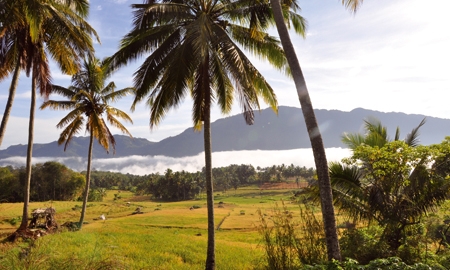Located on the Pacific Ring of Fire, Indonesia has more active volcanoes than any other country. They are most visible sign that the country has the world’s largest geothermal reserves – enough heat generated and stored in the earth to produce 29,000 megawatts of electricity
To put that in proportion, 29,000MW is the equivalent of 12 billion barrels of oil. Existing global geothermal power generating capacity amounts to approximately 11,000 MW.
Currently, only a tiny fraction – less than 5% – of this cost effective, reliable, sustainable, environmentally friendly and renewable source of energy is being exploited.
 “If the price is right and the forestry issues can be resolved, geothermal will be hugely beneficial.” “If the price is right and the forestry issues can be resolved, geothermal will be hugely beneficial.”
Widjajono Partowidagdo,
Vice-Minister of Energy and
Mineral Resources
------------------------------------
 “We have geothermal resources in abundance. It is important that we as a nation tap into this.” “We have geothermal resources in abundance. It is important that we as a nation tap into this.” Poernomo Abadi, Chairman of Indonesia Geothermal Association
------------------------------------
 “we still have deforestation problems and illegal logging, and that is something that we need to fix first.” “we still have deforestation problems and illegal logging, and that is something that we need to fix first.” Satya Yudha, Spokesperson for Commission VII |
However, that’s changing fast. A pledge by President Susilo Bambang Yudhoyono last year that he would increase subsidies for clean energy has prompted what has been described as biggest geothermal spending spree in Asia and the largest outside of the United States. Analysts say the investment boom could reach $30 billion.
Former U.S. Vice-President Al Gore has called Indonesia the first potential “geothermal superpower.”
World-class companies such as U.S. oil major Chevron, India’s Tata Group and Sumitomo of Japan are already involved. The national energy companies are stepping up their geothermal activities too.
State power firm PLN says it wants to boost its use of geothermal energy sources to 7%, and is launching three new geothermal power plants this year.
Pertamina Geothermal Energy (PGE), a subsidiary of the national oil and gas company, has been spending millions of dollars developing geothermal power plants in West Java, Sumatra and Sulawesi, and also expects to bring three more plants online this year. Pertamina also has a joint operation contract with Bali Energy, which is set to generate geothermal energy on the holiday resort island.
Recently State-Owned Enterprises Minister Dahlan Iskan announced that PGE is to become a joint subsidiary of Pertamina and PLN, the state electricity company to facilitate government plans to build 44 new geothermal plants to more than triple capacity to 4,000 MW by 2014. Discussions are, however, still at an early stage.
Geothermal energy is non-exportable, but as an alternative to fossil fuels it could reduce the amount Indonesia spends on importing energy and make a significant contribution to President Susilo Bambang Yudhoyono’s pledge to cut carbon emissions by 26% by 2020, while also contributing to boosting Indonesia’s electrification rate above 80% by 2014.
At present, Indonesia’s geothermal power plants have the capacity to generate just 1,341MW – only 4.6% of the total potential. The government aims to increase geothermal capacity to 4,000MW by 2014-15 and to 9,500MW by 2025, when it would account for approximately 33% of Indonesia’s electricity demand.
One of the problems that has held back development up to now has been that many geothermal reserves are located in protected forests – though this now appears to have been overcome. A memorandum of understanding (MOU) recently signed by the Ministry of Energy and Mineral Resources and the Ministry of Forestry removes licensing problems for the exploration of geothermal energy in 28 locations in forest conservation areas, and is likely to become a guideline for future geothermal projects.
Investment will also be encouraged now that the government has agreed to provide expanded guarantees to geothermal developers, covering risks during the exploration and construction phases. The financial, regulatory and technical challenges will be addressed at the World Geothermal Energy Summit 2012, which is to be held in Jakarta in July.
Widjajono Partowidagdo, Vice-Minister of Energy and Mineral Resources, says geothermal energy could offer big advantages to Indonesia. “If the price is right and the forestry issues can be resolved, geothermal will be hugely beneficial.”
He hopes the MOU will speed things up. “If the ministries work together, everything can be sorted out. It depends on our will and if we want to improve or not. The potential is there, but we need to move in the right direction. The contractors do not need the money – but they need a guarantee from the government that they are going to make a profit.”
Poernomo Abadi, chairman of Indonesia Geothermal Association, says 25% of Indonesia’s energy could come from renewable energy sources – including solar and wind, as well as coal bed methane and biofuels. “We have geothermal resources in abundance, spread throughout the country. It is important that we as a nation tap into this.”
He says the IGA is working with the government to remove the barriers that inhibit investors coming to Indonesia in order to develop geothermal activities. “All technology and knowledge from the U.S. and other countries is welcome in Indonesia,” he adds.
Satya Yudha, a member of the House of Representatives’ Commission VII on energy, mining, technology and the environment, says achieving the 26% carbon emissions reduction will be “quite a big job”, but using renewable resources will help.
“If you look at the forestry sector, we still have deforestation problems and illegal logging, and that is something that we need to fix first. If we can fulfill our energy needs with renewable energy, and optimize clean-burning fuel like gas, this complies with the country’s ambition to achieve a 26% cut.”

1 COMMENT
Kalau USA, Russia, China dan Eropa serta negara Afrika dan Amerka Latin semua mempunyai persediaan, maka pertanyaan saya bagaimana negara Indonesia menggunakan energnya?
indomigrant@yahoo.de